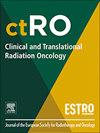Postoperative brachytherapy alone for 217 patients with early-stage oral cavity squamous cell carcinoma
IF 2.7
3区 医学
Q3 ONCOLOGY
引用次数: 0
Abstract
Introduction
Postoperative radiotherapy is generally recommended for pT1/2pN0 squamous cell carcinoma of the oral cavity (OSCC) if risk factors are present. Prospective studies are missing. Interventional radiotherapy offers a precise dose application. In this paper we analyze long-term efficacy and toxicity in a large single-center cohort of patients with early OSCC receiving sole postoperative brachytherapy (BT).
Material and methods
From 1998 to 2023, 217 patients were postoperatively treated with sole BT in our institute. The median follow-up was 110 months (range: 2–316). The primary objective was local control. Secondary outcomes were overall survival, cancer specific survival, and toxicity.
Results
The local recurrence rates for 12, 24, and 60 months were 7.1 %, 9.1 %, and 12.6 %. The disease-free survival was 89.7 %, 86.1 %, and 79.3 %. The overall survival rates at 12, 24, and 60 months were 94.4 %, 89.6 %, and 77.9 %. The cancer-specific survival was 97.1 %, 96.6 %, and 92.9 %, respectively. At two years, the rate of regional recurrence was 8.3 %. Patients without neck dissection had a significantly increased risk for lymph node recurrence (p = 0.025). Side effects ≥ grade 3 were seen in 14 % (30/217). 17 % (37/217) of patients developed a soft tissue necrosis (STN). Osteoradionecrosis (ORN) was seen in 7 % (15/217) of patients. A target volume > 15 cm3 was significantly associated with the occurrence of STN (p = 0.011) and ORN (p = 0.004).
Conclusions
Postoperative interventional radiotherapy for previously not irradiated patients with early-stage OSCC is a safe and efficient treatment. Randomized trials are needed to compare these results to omission of postoperative radiotherapy as well as external beam radiotherapy.
早期口腔鳞状细胞癌术后单独近距离放疗217例
如果存在危险因素,一般建议pT1/2pN0口腔鳞状细胞癌(OSCC)术后放疗。缺少前瞻性研究。介入放射治疗提供了精确的剂量应用。在本文中,我们分析了一个大型单中心队列的早期OSCC患者接受单独术后近距离放疗(BT)的长期疗效和毒性。材料与方法1998 ~ 2023年对我院217例患者进行足底BT术后治疗。中位随访为110个月(范围:2-316)。主要目标是局部控制。次要结果是总生存期、癌症特异性生存期和毒性。结果12、24、60个月局部复发率分别为7.1%、9.1%、12.6%。无病生存率分别为89.7%、86.1%和79.3%。12个月、24个月和60个月的总生存率分别为94.4%、89.6%和77.9%。肿瘤特异性生存率分别为97.1%、96.6%和92.9%。两年后,局部复发率为8.3%。未进行颈部清扫的患者淋巴结复发风险明显增加(p = 0.025)。副作用≥3级的发生率为14%(30/217)。17%(37/217)的患者发生软组织坏死(STN)。7%(15/217)的患者出现骨放射性坏死(ORN)。目标量>;15 cm3与STN (p = 0.011)和ORN (p = 0.004)的发生显著相关。结论术前未放疗的早期OSCC术后介入放疗是一种安全有效的治疗方法。需要随机试验来比较这些结果与术后遗漏放疗和外束放疗。
本文章由计算机程序翻译,如有差异,请以英文原文为准。
求助全文
约1分钟内获得全文
求助全文
来源期刊

Clinical and Translational Radiation Oncology
Medicine-Radiology, Nuclear Medicine and Imaging
CiteScore
5.30
自引率
3.20%
发文量
114
审稿时长
40 days
 求助内容:
求助内容: 应助结果提醒方式:
应助结果提醒方式:


